FORT WORTH, Texas – The American Paint Horse Association (APHA) officially turns 50 years old on February 16, 2012, commemorating a breed association that has registered more than one million horses.
APHA began as the brainchild of a unique horsewoman, Rebecca Tyler Lockhart of Gainesville, Texas, in the early 1960s. An avid admirer of beautifully colored horses of sound Western stock horse conformation, Tyler spoke up against the prevailing establishment and advocated the start-up of a Paint, stock-type horse registry. Overcoming seemingly insurmountable odds and almost unanimous disagreement from breeders, she began her quest for a breed registry at informal get-togethers in the kitchen of her home.
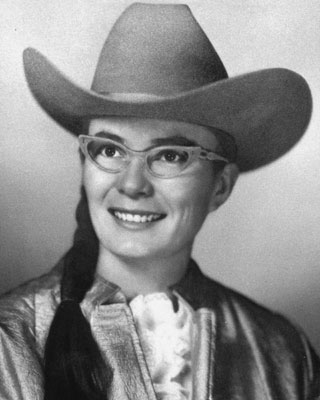 In 1962, Rebecca Tyler Lockhart forged ahead with a bold plan to start a new breed standard for horses. In 1962, Rebecca Tyler Lockhart forged ahead with a bold plan to start a new breed standard for horses. |
Later on, the group, which had grown to 16 strong, gathered at a café in Gainesville and laid the groundwork for the American Paint Stock Horse Association (APSHA). Incorporated as a nonprofit organization and managed by an executive committee and board of directors, the fledgling association had attracted 150 members and registered 250 horses by the end of 1962.
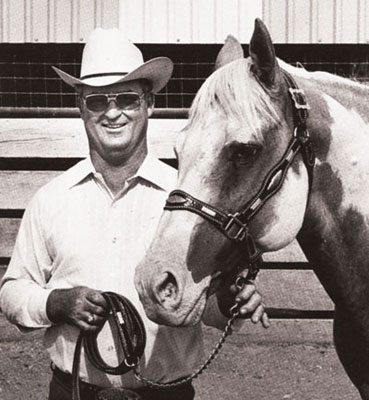 Founding member and 1976–1978 APHA President, Junior Robertson was the first person Rebecca Tyler Lockhart turned to when planning the Association. The Wauika, Oklahoma, horseman had bred working Paint Horses since the 1950s and sponsored the first Paint show ever held in Oklahoma. Founding member and 1976–1978 APHA President, Junior Robertson was the first person Rebecca Tyler Lockhart turned to when planning the Association. The Wauika, Oklahoma, horseman had bred working Paint Horses since the 1950s and sponsored the first Paint show ever held in Oklahoma. |
 Convinced by Rebecca Tyler Lockhart that the American Paint Stock Horse Association was going to have a great future, foundation Paint Horse breeder Jack Campbell of Douglas, Wyoming, was instrumental in promoting the breed and the Association in the West. Convinced by Rebecca Tyler Lockhart that the American Paint Stock Horse Association was going to have a great future, foundation Paint Horse breeder Jack Campbell of Douglas, Wyoming, was instrumental in promoting the breed and the Association in the West. |
Some notable early APSHA registrations include Bandit’s Pinto, a 3-year-old tobiano stallion, who had the honor of being registration Number 1. The first 20 APSHA registration numbers were reserved for stallions, but Lockhart reserved Number 21 specifically for a flashy tobiano mare named Calamity Jane, who won fame in the Quarter Horse-dominated cutting arena by being named the NCHA Paint Horse of the Year for three years running. Lockhart declared that the mare “was an example to the entire world of all that a Paint Horse could be.”
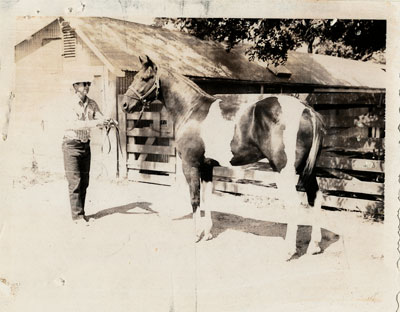 Bandit’s Pinto, a 3-year-old black tobiano stallion owned by William Gooch of Fort Worth, Texas was the first of 2,599 horses to be registered by the APSHA. Bandit’s Pinto, a 3-year-old black tobiano stallion owned by William Gooch of Fort Worth, Texas was the first of 2,599 horses to be registered by the APSHA. |
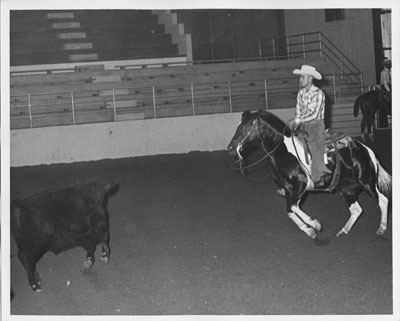 The flashy tobiano mare began cutting ten years before the formation of the APSHA. During her 13-year cutting career she amassed $24,591 in total earnings. The flashy tobiano mare began cutting ten years before the formation of the APSHA. During her 13-year cutting career she amassed $24,591 in total earnings. |
The first registered gelding was a 1957 chestnut overo named Wahoo King, who began his career as a top roping horse. Campaigned at halter by Junior Robertson, one of APSHA’s founding members, the striking gelding attracted a legion of fans to the new association.
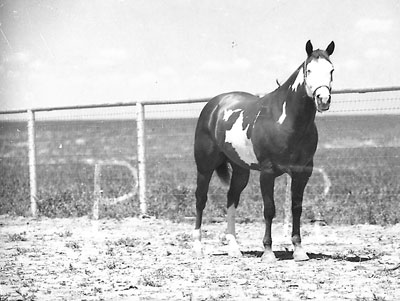 This 1957 chestnut overo gelding began his career as a top notch roping horse, but was also shown successfully at halter in the 1960s. This 1957 chestnut overo gelding began his career as a top notch roping horse, but was also shown successfully at halter in the 1960s. |
During the same period, an offshoot of the American Quarter Horse Association (AQHA) called the American Paint Quarter Horse Association (APQHA) had been formed in Amarillo to register non-solid colored foals resulting from the mating of two Quarter Horses. AQHA would not register these horses with excessive white markings, thinking that such markings were a sign of non-purebred breeding.
On June 3, 1965, the two organizations merged to become the modern day American Paint Horse Association, with headquarters in downtown Forth Worth, Texas. By the end of that year, APHA had 1,350 members and 3,800 horses in its registry. The new registry began registering horses starting with Number 2,600, which went to Tuff Cat, the colt that won the National Championship in the 1964 Stallion Class at the national show in Kansas City.
 Tuff Cat won two firsts and one second in the three go-rounds to capture the stallion class at the 1964 National Championship Show and earn the first newly merged APHA registration in 1965. Tuff Cat won two firsts and one second in the three go-rounds to capture the stallion class at the 1964 National Championship Show and earn the first newly merged APHA registration in 1965. |
Endowed with championship breeding, Yellow Mount’s (registration number 3,300) contribution to the breed is second to none. Owned by Stanley and Jodie Williamson of Iowa Park, Texas, the big red dun overo stallion has contributed a total of 102,963 descendants to APHA’s registry, accounting for 10.1% of the total. The image of his head has become the face of APHA and is used on all logos.
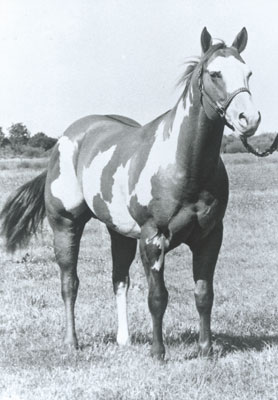 Yellow Mount was APHA’s second Supreme Champion and the only winner to sire five other recipients of that award. Yellow Mount was APHA’s second Supreme Champion and the only winner to sire five other recipients of that award. |
Since 1963, regional Paint Horse clubs have brought the ideals of APHA—a friendly atmosphere, a high regard for its members, enrichment of Paint Horse ownership and the promotion of family values—to horse enthusiasts at the local level. Beginning with six clubs, the network of Paint Horse clubs has grown to 111 active regional and international organizations.
 In 1974, Dan Simons of Fort Sauderdale, Florida, was elected as the first AjPHA president. As the Youth Association’s leader, Dan set up a strong program that continues to benefit its members and the Paint Horse breed today. In 1974, Dan Simons of Fort Sauderdale, Florida, was elected as the first AjPHA president. As the Youth Association’s leader, Dan set up a strong program that continues to benefit its members and the Paint Horse breed today. |
The first glimmer of a youth-based Paint Horse organization began in 1971, when an enthusiastic group of 40 young people representing 12 states met in Tulsa, Oklahoma. APHA began offering Youth memberships in 1972 and that number has grown to almost 6,000 members.
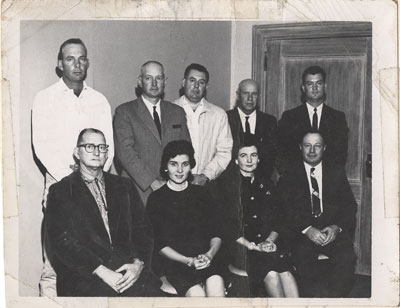 One of the first regional Paint Horse clubs chartered in 1963, the Oklahoma Paint Stock Horse Club officers were (from left to right) back row: Dick Barrett, Truman Moody, Quenton Foster, Ed Akin and Junior Robertson; front row; Butch Gore, mary Barrett, Betty Crump and Art Beall. The club continues to be active, and has been recognized by APHA as an outstanding club. One of the first regional Paint Horse clubs chartered in 1963, the Oklahoma Paint Stock Horse Club officers were (from left to right) back row: Dick Barrett, Truman Moody, Quenton Foster, Ed Akin and Junior Robertson; front row; Butch Gore, mary Barrett, Betty Crump and Art Beall. The club continues to be active, and has been recognized by APHA as an outstanding club. |
APHA’s premier event—the World Championship Show— has evolved through the years and looks quite different today than at its 1963 inception. A traveling national horse show until 1985, the early years featured many firsts—the popular APHA Queen contest, first show held east of the Mississippi River (Lexington, Kentucky), first five-judge show, and unprecedented growth. In 1996, the Will Rogers Equestrian Center in Fort Worth, Texas, became the World Championship Show’s permanent home. In 2009, APHA debuted its dual-show format, offering a primarily Youth show in June and an Amateur and Open show in November.
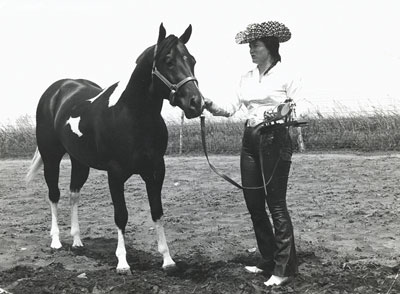 Taking place in December on the wind-swept West Texas plains, APSHA’s first major show—the 1963 Finals in Lubbock, Texas—awarded a trophy saddle and 19 high-point trophies. Hank’s Koko was one of the show’s national champions at halter. Taking place in December on the wind-swept West Texas plains, APSHA’s first major show—the 1963 Finals in Lubbock, Texas—awarded a trophy saddle and 19 high-point trophies. Hank’s Koko was one of the show’s national champions at halter. |
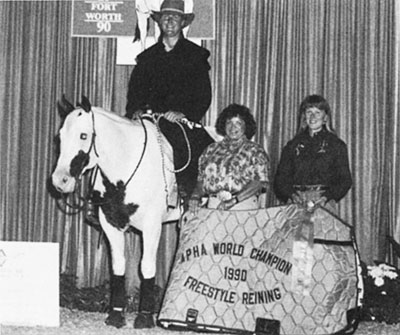 Big changes came to APHA in 1990: the National Show forever morphed into the World Championship Show and returned to Fort Worth. Performing with Chiqua Versa, Troy Heikes’ memorable “Man from Snowy Fiver” routine won the inaugural Freestyle Reining Sweepstakes—an event that still ranks as one of the APHA’s most popular spectator classes. Big changes came to APHA in 1990: the National Show forever morphed into the World Championship Show and returned to Fort Worth. Performing with Chiqua Versa, Troy Heikes’ memorable “Man from Snowy Fiver” routine won the inaugural Freestyle Reining Sweepstakes—an event that still ranks as one of the APHA’s most popular spectator classes. |
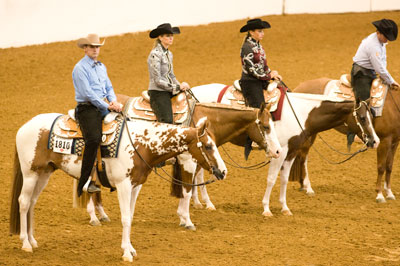 For the first time in history, horses must meet participation requirements for the 2012 World Championship Shows. Qualifying is done by participating in four different APHA-approved shows, with a minimum of eight judges total during the qualifying period. For the first time in history, horses must meet participation requirements for the 2012 World Championship Shows. Qualifying is done by participating in four different APHA-approved shows, with a minimum of eight judges total during the qualifying period. |
Paints have made their mark on the racetrack as well in the last 50 years. In fact, they were raced long before official recognition of the sport by APHA in 1966. That year there were nine official races for a total of $1,290 in purse money. Today there are close to 500 official races per year with a total purse money exceeding $4 million.
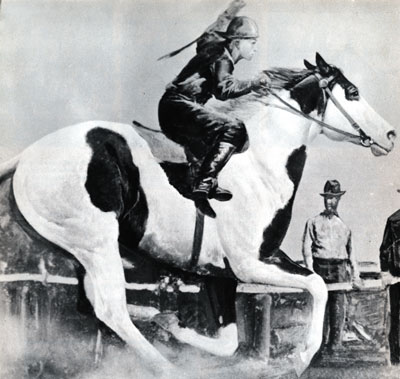 Painted Joe, one of the top racehorses of his day, claimed APSHA registration Number 5. The black tobiano stallion was match-raced three times against famed AQHA sprinter GHrey Badget II and won every contest. Painted Joe, one of the top racehorses of his day, claimed APSHA registration Number 5. The black tobiano stallion was match-raced three times against famed AQHA sprinter GHrey Badget II and won every contest. |
As the horse breeding business continued to transform at a rapid rate, APHA assumed a leadership role, stepping to the forefront of Western breed registries. In 1997, the American Paint Horse Association became the second largest equine breed registry, second only to AQHA. APHA was the first Western horse breed to allow the use of transported cooled semen and was also the first to make online foal registration available to its members.
The Association has many events scheduled for this milestone year. On February 16, a reception will be held at the Chili’s restaurant in Gainesville, Texas, site of the old Curtwood Motel, one of the places where the founders met to plan the new association back in 1962. Memorabilia will be hung in the restaurant and a historical marker is planned for the site.
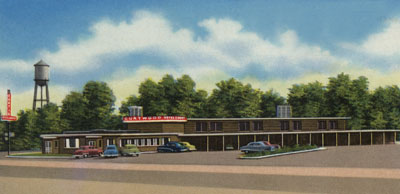 The Curtwood Motel in Gainesville, Texas, was one of the locations where the founding members of the APSHA met to lay the foundation of of the new association. A Chilis restaurant is currently located at the site of the old motel. The Curtwood Motel in Gainesville, Texas, was one of the locations where the founding members of the APSHA met to lay the foundation of of the new association. A Chilis restaurant is currently located at the site of the old motel. |
In anticipation of the anniversary, APHA recently created a Hall of Fame at its international headquarters in Fort Worth, and an inaugural class of 25 members and 25 horses will be inducted into this Hall of Fame at the Association’s annual convention in October. APHA has created a 50th Anniversary Gist Silversmith belt buckle, as well as a 50th Anniversary calendar detailing the history of the Association. Both items are available through APHA’s General Store.
 Beautifully designed by Gist Silversmiths, this limited edition buckle is crafted in silver and gold electroplate with two semi-precious ruby stones. The buckle is a colorful reproduction of the 50th Anniversary logo featuring the distinctive APHA horse logo in brown and white resin. Beautifully designed by Gist Silversmiths, this limited edition buckle is crafted in silver and gold electroplate with two semi-precious ruby stones. The buckle is a colorful reproduction of the 50th Anniversary logo featuring the distinctive APHA horse logo in brown and white resin. |
APHA’s dedicated staff, executive committee, board of directors and members all look forward to an exciting year of celebration and will continue to work tirelessly to move the Association forward through the next 50 years and beyond.




